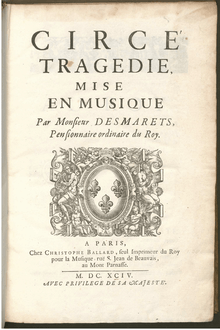Circé (Desmarets)

Circé (Circe) is an opera by the French composer Henri Desmarets, first performed at the Académie Royale de Musique (the Paris Opera) on 1 October 1694. It takes the form of a tragédie en musique in a prologue and five acts. The libretto by Louise-Geneviève Gillot de Saintonge, concerns the sorceress Circe who appears in Greek mythology and famously in Homer's Odyssey.
Henri Desmarets
Henri Desmarets (1661 – 1741) was a French composer in the Baroque era associated with the court of King Louis XIV. Though considered to be very talented, most of his works were not received well, and his personal life was equally as troubled. He is known for his masterfully written sacred grands motets.[1]
Life and work
Desmarets was born in Paris in 1661.[2] Not much is known about his early life but many accounts exist of an infamous adulthood. After the death of his first wife in August 1696, he then married his eighteen-year-old student, the daughter of the tax collector for the city of Senlis. Sources detailing the affair range from painting the two simply as an eloping couple to denouncing Desmarets as a kidnapper.
As a consequence, a bounty was put on Desmarets' head, and he and his new wife were forced to leave the country. He found work with King Philip V of Spain, but due to a lack of favorability among the Spanish populace, he moved on to a job with the Duke of Lorraine in 1707.
Desmarets' marriage was finally recognized and his transgression pardoned by the French court after the death of Louis XIV. His second wife died in 1727. The composer stayed in Lorraine until his death in 1741, aged eighty.[3]
At the court of the sun king, Desmarets was a pupil of Jean-Baptiste Lully. He wrote some sacred music, but most notable are his operas, though they all flopped except for the work Venus et Adonis. His only successes were the grands motets he wrote for the church; they were widely considered to have a style in keeping with contemporary trends while also showing compositional mastery. He also ghostwrote some motets for fellow court composer Coupillet.
Performance and reception
Circe was first performed in 1694 at the Paris Opera.[4] It was not received well; most of Desmarets' operas were said to have mimicked Lully's music in a way that produced material similar but inferior to it. No fault of Desmarets', Lully's monopoly on court music cast a shadow in which any potential individuality Desmarets had was quashed. This may have contributed to the generally negative sentiment toward his work evident in reviews written at the time.[5][6]
Libretto
The libretto to Circe was written by Louise Genevieve Gillot de Saintonge. It is based on the Greek myth by the same name.
Louise Genevieve Gillot de Saintonge (1650-1718) was a French novelist and librettist. In addition to writing this libretto, she also wrote the libretto for Desmaret's opera Didon.
Circe in mythology
The eponymous character in this myth appears often in ancient literature as an enchantress well-versed in potions and sorcery. She is mainly associated with Homer's Odyssey. In this iteration of the tale, she lures the main character Odysseus and his crew to a wine- and potion-laced feast that leads to Odysseus, with whom she has fallen in love, to remain on her island for a year. She then frees him and directs him home.
Tragédie en musique
Circe falls under the category of tragedie en musique (also known as tragedie lyrique), a genre of opera formed and popularized in the Baroque era by Lully and carried on until the end of the period. Operas in this genre served the purpose of edifying the king and exemplify regality with stately rhythmic structures and consonant harmonies. Most were based on Greek myth and tragedy, hence its name, literally "tragedy set to music."[7][8]
Score
Though the similarities between Desmarets' and Lully's music were written off by bitter critics as the sign of a composer failing to come into his own, the use of one of Desmarets' musical structures in later music suggests quietly admitted approval within the musical community. At the time one trend was to highlight low voices and sonorities, which the composer furthered through choruses that featured a single exposed melody to be sung by bass voices. This can be seen in the songes affreux in Circe.
The prologue is a good example of the homophony characteristic of French music at the time the opera was written, and includes points of imitation, or repeated material in succession between different instrument and voice parts which may mimic a fugue.
The most popular excerpt of the piece is the rigaudon transcribed by Ernst Pauer for piano.
References
- ↑ Mason Greene, David (1985). Greene's Biographical Encyclopedia of Composers. Doubleday and Company. pp. 186–187.
- ↑ "North Carolina School of the Arts /UNCSA". libcat.uncsa.edu. Retrieved 2015-12-01.
- ↑ Green, David Mason. Greene's Biographical Encyclopedia of Composers. Doubleday and Company.
- ↑ Taruskin, Richard. Oxford History of Western Music: Music in the Seventeenth and Eighteenth Centuries. Oxford.
- ↑ Sadle, Stanley. New Grove Dictionary of Opera. Grove's Dictionaries of Music.
- ↑ Sadle, Stanley. Oxford Dictionary of Music and Musicians. Oxford.
- ↑ "Louise-Geneviève Gillot de Saintonge" (in French).
- ↑ Anthony, James R. French Baroque Music from Rameau to Beaujoyeulx.
Further reading
- (French) Félix Clément and Pierre Larousse Dictionnaire des Opéras, Paris, 1881, page 163.